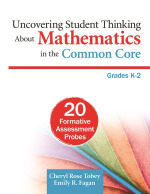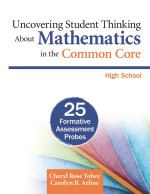Learn from Linda Gojak and Ruth Harbin-Miles, authors of The Common Core Mathematics Companion: The Standards Decoded, Grades 3-5, the impactful models and applications that lead students to a better and deeper understanding of division.
Learn from Linda Gojak and Ruth Harbin-Miles, authors of The Common Core Mathematics Companion: The Standards Decoded, Grades 3-5, the impactful models and applications that lead students to a better and deeper understanding of division.

Use this lesson from Uncovering Student Thinking About Mathematics in the Common Core, Grades K-2, to probe student understanding of addition and subtraction.
Students extend their understanding of place value by bundling tens with this lesson from The Common Core Mathematics Companion, K-2. (Elementary)
Students apply and extend previous understanding of multiplication and division to multiply and divide fractions using this lesson from The Common Core Mathematics Companion, 3-5. (Elementary)

Use this lesson from Uncovering Student Thinking About Mathematics in the Common Core, Grades 6-8, on linear equations to probe student understanding and misconceptions.

Use this lesson from Uncovering Student Thinking About Mathematics in the Common Core, High School, on equivalent expressions to probe student understanding and misconceptions.
Learn how to design structured inquiry, guided inquiry, and open inquiry tasks on the topic of straight lines with this unit from Concept-Based Mathematics.
Use the following template and lesson plan from Teaching Mathematics in the Visible Learning Classroom, Grades 6-8, to help your students analyze each other’s work for a more effective teaching practice.
Included in this excerpt from Teaching Mathematics in the Visible Learning Classroom, High School, is a Peer Assisted Review (PAR) activity on on understanding volume formulas. PARs are a great resource to help students reflect on their own thinking and solve meaningful problems.
This excerpt from Visible Learning for Mathematics, Grades K-12, explains how making learning visible starts with teacher clarity and the strategic use of learning intentions and success criteria promote student self-reflection and metacognition.
This lesson from Daily Routines to Jump-Start Math Class, Middle School, helps students learn to analyze mathematic scenarios based upon their environment. Students will learn to apply mathematics concepts to real world situations that lead to solutions and reasoning.
Using this lesson from The Common Core Mathematics Companion, 6-8, students analyze proportional relationships and use them to solve real-world and mathematical problems (Secondary).